Muscovy duck
| Muscovy duck | |
|---|---|
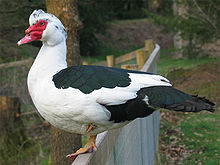
| |
| Scientific classification | |
| Domain: | Eukaryota |
| Kingdom: | Animalia |
| Phylum: | Chordata |
| Class: | Aves |
| Order: | Anseriformes |
| Family: | Anatidae |
| Genus: | Cairina Fleming,1822 |
| Species: | C. moschata
|
| Binomial name | |
| Cairina moschata (Linnaeus,1758)
| |
| Subspecies | |
| |
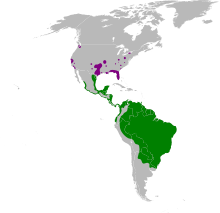
| |
Natural range Introduced feral populations
| |
| Synonyms | |
|
Anas moschataLinnaeus, 1758 | |
TheMuscovy duck(Cairina moschata) is aducknative to theAmericas,from theRio Grande ValleyofTexasandMexicosouth toArgentinaandUruguay.FeralMuscovy ducks are found inNew Zealand,Australia,and inCentral and Eastern Europe.Small wild and feral breeding populations have also established themselves in theUnited States,particularly inFlorida,Louisiana,Massachusetts,the Big Island ofHawaii,as well as in many other parts ofNorth America,including southernCanada.[3][4]
It is a large duck, with the males about 76 cm (30 in) long, and weighing up to 7 kg (15 lb). Females are noticeably smaller, and only grow to 3 kg (6.6 lb), roughly half the males' size. The bird is predominantly black and white, with the back feathers being iridescent and glossy in males, while the females are more drab. The amount of white on the neck and head is variable, as well as the bill, which can be yellow, pink, black, or any mixture of these colors. It may have white patches or bars on the wings, which become more noticeable during flight. Both sexes have pink or redwattlesaround the bill, those of the male being larger and more brightly colored.[5][6]
Although the Muscovy duck is atropicalbird, it adapts well to cooler climates, thriving in weather as cold as −12 °C (10 °F) and able to survive even colder conditions.[7][8]In general,Barbary duckis the term used forC. moschatain aculinarycontext.
The domestic subspecies,Cairina moschata domestica,is commonly known inSpanishas thepato criollo.They have been bred sincepre-Columbiantimes byNative Americansand are heavier and less able to fly long distances than the wild subspecies. Theirplumagecolor is also more variable. Other names for the domestic breed in Spanish arepato casero( "household duck" ) andpato mudo( "mute duck" ).
Description
[edit]
All Muscovy ducks have longclawson their feet and a wide, flat tail. In the domestic drake (male), length is about 86 cm (34 in) and weight is 4.6–6.8 kg (10–15 lb), while the domestic hen (female) is much smaller, at 64 cm (25 in) in length and 2.7–3.6 kg (6.0–7.9 lb) in weight. Large domesticated males often weigh up to 7 kg (15 lb), and large domesticated females up to 4 kg (8.8 lb).
The true wild Muscovy duck, from which all domestic Muscovies originated, is blackish, with large white wing patches. Length can range from 66 to 84 cm (26 to 33 in), wingspan from 137 to 152 cm (54 to 60 in) and weight from 1.1 to 4.1 kg (2.4 to 9.0 lb). On the head, the wild male has a short crest on the nape. The bill is black with a speckling of pale pink. A blackish or dark red knob can be seen at the bill base, which is similar in colour to the bare skin of the face. The eyes are yellowish-brown. The legs and webbed feet are blackish. The wild female is similar in plumage, but much smaller, with a feathered face and lacking the prominent knob. The juvenile is duller overall, with little or no white on the upperwing.[9]
Domesticated birds may look similar; most are dark brown or black mixed with white, particularly on the head.[10]Other colors, such as lavender or all-white, are also seen. Both sexes have a nude black-and-red or all-red face; the drake also has pronouncedcarunclesat the base of the bill and a low erectilecrestof feathers.[8]C. moschataducklings are mostly yellow with buff-brown markings on the tail and wings. For a while after hatching, juveniles lack the distinctive wattles associated with adult individuals, and resemble the offspring of various other ducks, such asmallards.Some domesticated ducklings have a dark head and blue eyes, others a light brown crown and dark markings on their nape. They are agile and speedyprecocialbirds.
The drake has a low breathy call, and the hen a quiet trilling coo.
Thekaryotypeof the Muscovy duck is 2n=80, consisting of three pairs ofmacrochromosomes,36 pairs ofmicrochromosomes,and a pair ofsex chromosomes.The two largest macrochromosome pairs aresubmetacentric,while all otherchromosomesareacrocentricor probablytelocentricfor the smallest microchromosomes. The submetacentric chromosomes and theZ (female) chromosomeshow rather littleconstitutive heterochromatin(C bands), while theW chromosomesare at least two-thirds heterochromatin.[11]
Male Muscovy ducks havehelicalpenises that become erect to 19 cm (7 in) in 0.3s.Females have vaginas that coil in the opposite direction that appear to have evolved to limitforced copulationby males.[12][13]
Etymology
[edit]Common name “Muscovy”
[edit]
"Muscovy"is an old name for the region of Russia surrounding Moscow, but these ducks are neither native there nor were introduced there before they became known in Western Europe. It is not quite clear how the term came about; it very likely originated between 1550 and 1600, but did not become widespread until somewhat later.
In one suggestion, it has been claimed that theCompany of Merchant Adventurers to New Landstraded these ducks to Europe occasionally after 1550;[14]thischartered companybecame eventually known as the "Muscovy Company"or" Muscovite Company "so the ducks might thus have come to be called" Muscovite ducks "or" Muscovy ducks "in keeping with the common practice of attaching the importer's name to the products they sold.[14]But while the Muscovite Company initiated vigorous trade with Russia, they hardly, if at all, traded produce from the Americas; thus, they are unlikely to have tradedC. moschatato a significant extent.
Alternatively—just as in the "turkey"(which is also from North America, not Turkey) and the"guineafowl"(which are not limited toGuinea)— "Muscovy" might be simply a generic term for an exotic place, in reference to the singular appearance of these birds. This is evidenced by other names suggesting the species came from lands where it is not actually native, but from where much "outlandish" produce was imported at that time (see below).
Yet another view—not incompatible with either of those discussed above—connects the species with theMuisca,aNative Americannation in today's Colombia. The duck is native to these lands also, and it is likely that it was kept by the Muisca as a domestic animal to some extent. It is conceivable that a term like "Muisca duck", hard to comprehend for the average European of those times, would be corrupted into something more familiar. Likewise, theMiskito Indiansof theMiskito Coastin Nicaragua and Honduras heavily relied on it as a domestic species, and the ducks as well may have been named after this region.
Species name “moschata”
[edit]
Linnaeus’ description ofAnas moschataonly consists of a curt but entirely unequivocal[Anas] facie nuda papillosa( "A duck with a naked and carunculated face" ), and his primary reference is his earlier workFauna Svecica.[15]But Linnaeus refers also to older sources, wherein much information on the origin of the common name is found.
Conrad Gessneris given by Linnaeus as a source, but theHistoria animaliummentions the Muscovy duck only in passing.[16]Ulisse Aldrovandi[17]discusses the species in detail, referring to the wild birds and its domestic breeds variously asanas cairina,anas indicaoranas libyca– "duck fromCairo","Indian duck "(in reference to theWest Indies) or "Libyanduck ". But hisanas indica(based, like Gessner's brief discussion, ultimately on the reports ofChristopher Columbus's travels) also seems to have included anotherspecies,[18]perhaps awhistling-duck(Dendrocygna). Already however the species is tied to some more or less nondescript "exotic" locality – "Libya" could still refer toany place in Northern Africaat that time – where it did not natively occur.Francis Willughbydiscusses "The Muscovy duck" asanas moschataand expresses his belief that Aldrovandi's and Gessner'sanas cairina,anas indicaandanas libyca(which he calls "The Guiny duck", adding another mistaken place of origin to the list) refer to the very same species.[19]Finally,John Rayattempts to clear up the confusion by providing an alternative explanation for the name'setymology:
In English, it is calledThe Muscovy-Duck,though this is not transferred from Muscovia [theNeo-Latinname of Muscovy], but from the rather strong musk odour it exudes.[20]
Linnaeus came to witness the birds' "gamey"aroma first-hand, as he attests in theFauna Svecicaand again in thetravelogueof this 1746Västergötlandexcursion.[15][21]Similarly, theRussianname of this species,muskusnaya utka(Мускусная утка), means "musk duck" – without any reference to Moscow – as do theBokmålandDanishmoskusand,Dutchmuskuseend,Finnishmyskisorsa,Frenchcanard musqué,GermanMoschusente,Italiananatra muschiata,Spanishpato almizcladoandSwedishmyskand.In English, however,musk duckrefers to theAustralianspeciesBiziura lobata.
Genus name "Cairina"
[edit]The currently assignedgenus nameCairina,meanwhile, traces its origin to Aldrovandi and the mistaken belief that the birds came fromEgypt:translated, the current scientific name of the Muscovy duck means "the musky one from Cairo".
Other names
[edit]In some regions the name"Barbary duck"is used for domestic and "Muscovy duck" for wild birds; in other places, "Barbary duck" refers specifically to the dressed carcass, while "Muscovy duck" applies to livingC. moschata,regardless of whether they are wild or domestic. In general, "Barbary duck" is the usual term forC. moschatain aculinarycontext.
Taxonomy and systematics
[edit]
The species was first scientifically described byCarl Linnaeusin his 1758 edition ofSystema NaturaeasAnas moschata,[22]literally meaning "muskduck ". It was later transferred to the genusCairina,making its current binomial nameCairina moschata.
The Muscovy duck was formerly placed into theparaphyletic"perching duck"assemblage, but subsequently moved to thedabbling ducksubfamily(Anatinae). Analysis of themtDNAsequencesof thecytochromebandNADH dehydrogenasesubunit2genes,[23]however, indicates that it might be closer to the genusAixand better placed in theshelducksubfamilyTadorninae.In addition, the other species ofCairina,the rarewhite-winged duck(C. scutulata), seems to belong to a distinct genus (Asarcornis).
Ecology
[edit]Thisnon-migratoryspecies normally inhabitsforestedswamps,lakes,streamsand nearbygrasslandand farm crops,[24]and often roosts in trees at night. The Muscovy duck's diet consists of plant material (such as theroots,stems,leaves,andseedsofaquatic plantsandgrasses,as well as terrestrial plants, including agriculturalcrops) obtained by grazing or dabbling in shallow water, and smallfish,amphibians,reptiles,crustaceans,spiders,insects,millipedes,andworms.[25][26][27][28]This is an aggressive duck; males often fight over food, territory or mates. The females fight with each other less often. Some adults will peck at the ducklings if they are eating at the same food source.
The Muscovy duck has benefited from nest boxes inMexico,but is somewhat uncommon in much of the eastern part of its range due to excessive hunting. It is not considered a globally threatened species by theIUCN,however, as it is widely distributed.[1]
Reproduction
[edit]
This species, like themallard,does not form stable pairs. They will mate on land or in water. Domestic Muscovy ducks can breed up to three times each year.
The hen lays a clutch of 8–16 white eggs, usually in a tree hole or hollow, which areincubatedfor 35 days. The sitting hen will leave the nest once a day from 20 minutes to one and a half hours, and will then defecate, drink water, eat and sometimes bathe. Once the eggs begin to hatch, it may take 24 hours for all the chicks to break through their shells. When feral chicks are born, they usually stay with their mother for about 10–12 weeks. Their bodies cannot produce all the heat they need, especially in temperate regions, so they will stay close to the mother, especially at night.
Often, the drake will stay in close contact with the brood for several weeks. The male will walk with the young during their normal travels in search for food, providing protection. Anecdotal evidence fromEast Anglia,U.K. suggests that, in response to different environmental conditions, other adults assist in protecting chicks and providing warmth at night. It has been suggested that this is in response to local efforts to cull the eggs, which has led to an atypical distribution of males and females, as well as young and mature birds.
For the first few weeks of their lives, Muscovy chicks feed on grains, corn, grass, insects, and almost anything that moves. Their mother instructs them at an early age how to feed.
Feral bird
[edit]

FeralMuscovy ducks can breed near urban and suburban lakes and on farms, nesting in tree cavities or on the ground, under shrubs in yards, on apartment balconies, or under roof overhangs. Some feral populations, such as that in southernFlorida,have a reputation of becomingpestson occasion.[29]At night they often sleep at water, if there is a water source available, to flee quickly from predators if awakened. Small populations of Muscovy ducks can also be found inEly, Cambridgeshire,Calstock, Cornwall,andLincoln, Lincolnshire,U.K. Muscovy ducks have also been spotted in theWalsall Arboretum.There has been a small population in thePavilion Gardenspublic park inBuxton,Derbyshire for many years.[30]
In the U.S., Muscovy ducks are considered a non-native species. An owner may raise them for food production only (not for hunting). Similarly, if the ducks have no owner,50CFRPart 21 (Migratory Bird Permits) allows the removal or destruction of the ducks, their eggs and their nests anywhere in the United States outside ofHidalgo,StarrandZapataCounties in Texas, where they are considered indigenous. The population in southern Florida is considered, with numbers in the several thousands, to be established enough to be considered "countable" for bird watchers.[31]
Legal methods to restrict breeding include not feeding these ducks, deterring them with noise or chasing them away.
Although legislation passed in the U.S. prohibiting trade of Muscovy ducks, Fish and Wildlife Services intend to revise the regulations. They are not currently implementing them, though release of Muscovy ducks to the wild outside their natural range is prohibited.[32]
Domestication
[edit]
Muscovy ducks had been domesticated by variousNative Americancultures in theAmericaswhenColumbusarrived in the Bahamas. A few were brought onto Columbus' ship theSanta Maria,they then sailed back to Europe by the 16th century.
The Muscovy duck has been domesticated for centuries, and is widely traded as "Barbary duck". Muscovy breeds are popular because they have stronger-tasting meat—sometimes compared to roastbeef—than the usualdomestic ducks,which are descendants of themallard(Anas platyrhynchos). The meat is lean when compared to the fatty meat of mallard-derived ducks, its leanness and tenderness being often compared toveal.Muscovy ducks are also less noisy, and sometimes marketed as a "quackless"duck; even though they are not completely silent, they do not actually quack (except in cases of extreme stress). Many backyard duck owners report that Muscovy ducks have more personality than mallard-derived ducks, often comparing them to dogs for their tameness and willingness to approach owners for food or stroking.[33]The carcass of a Muscovy duck is also much heavier than most other domestic ducks, which makes it ideal for the dinner table.
Domesticated Muscovy ducks, like those pictured, often have plumage features differing from other wild birds. White breeds are preferred for meat production, as darker ones can have muchmelaninin the skin, which some people find unappealing.
The Muscovy duck can be crossed with mallards in captivity to producehybridsknown asmulards( "muleducks ") because they aresterile.Muscovy drakes are commercially crossed with mallard-derived hens either naturally or byartificial insemination.The 40–60% of eggs that are fertile result in birds raised only for their meat or for production offoie gras:they grow fast like mallard-derived breeds, but to a large size like Muscovy ducks. Conversely, though crossing mallard-derived drakes with Muscovy hens is possible, the offspring are neither desirable for meat nor for egg production.[34][35]
In addition, Muscovy ducks are reportedly crossbred inIsraelwith mallards to produce kosher duck products. Thekashrutstatus of the Muscovy duck has been a matter ofrabbinicdiscussion for over 150 years.[35]
A study examining birds in northwesternColombiafor bloodparasitesfound the Muscovy duck to be more frequently infected withHaemoproteusandmalaria(Plasmodium) parasites thanchickens,domestic pigeons,domestic turkeysand, in fact, almost all wild bird species also studied. It was noted that in other parts of the world,chickenswere more susceptible to such infections than in the study area, but it may well be that Muscovy ducks are generally more often infected with such parasites (which might not cause pronounced disease, though, and are harmless to humans).[36]
Gallery
[edit]-
Hatchling
-
Young duckling
-
Older duckling
-
Fledgling
-
One-year-old (still immature)
-
Mating pair
-
White Muscovy duck
-
Mating in water; the large drake entirely submerges the smaller hen
-
Black wild type Muscovy duck inBaton Rouge
-
Domesticducklings after 25 days, left perhaps little distinction, the weight makes it clear that the male (1 and 2) are already heavier than the females (3 and 4).[37]
-
Domestic Muscovy duck
See also
[edit]References
[edit]- ^abBirdLife International (2018)."Cairina moschata".IUCN Red List of Threatened Species.2018:e.T22680061A131911211.doi:10.2305/IUCN.UK.2018-2.RLTS.T22680061A131911211.en.Retrieved13 November2021.
- ^Donkin 1988.
- ^"Muscovy - an overview".Sciencedirect.com.Retrieved2021-06-17.
- ^"Poultry Breeds - Muscovy Duck — Breeds of Livestock, Department of Animal Science".afs.okstate.edu.Retrieved2021-06-17.
- ^"Muscovy Duck".ebird.org.Retrieved2021-06-17.
- ^"Muscovy Duck".txtbba.tamu.edu.Retrieved2021-06-17.
- ^Holderread 2001,p. 17
- ^ab"Non-Native Aquatic Species in the Gulf of Mexico and South Atlantic Regions".Gulf States Marine Fisheries Commission. Archived fromthe originalon 12 April 2008.Retrieved6 February2012.
- ^"Muscovy Duck".Oiseaux-birds.com.
- ^Cisneros-Heredia 2006.
- ^Wójcik & Smalec 2008.
- ^Brennan, P. L. R.; Clark, C. J.; Prum, R. O. (2009-12-23)."Explosive eversion and functional morphology of the duck penis supports sexual conflict in waterfowl genitalia".Proceedings of the Royal Society B: Biological Sciences.277(1686): 1309–1314.doi:10.1098/rspb.2009.2139.ISSN0962-8452.PMC2871948.PMID20031991.
- ^Sample, Ian (23 December 2009)."Video reveals twists and turns of genital warfare in ducks".The Guardian.Retrieved23 December2009.
- ^abHolderread 2001,pp. 73–74
- ^abLinnaeus, Carl(1746)."98".Fauna Svecica Sistens Animalia Sveciæ Regni, etc(in Latin) (1st: 35 ed.). Leiden ( "Lugdunum Batavorum" ): Conrad & Georg Jacob Wishoff.
- ^Gessner 1555,p. 118; not p. 122 as per Linnaeus (1741, 1758): seeAldrovandi 1637,p. 192 andWillughby 1676,p. 295
- ^Aldrovandi 1637,pp. 192–201
- ^Aldrovandi 1637,pp. 192, 194:Anas indica alia
- ^Willughby 1676,pp. 294–295
- ^Ray, John(Joannis Raii) (1713):Synopsis methodica avium & piscium: opus posthumumArchived2011-07-16 at theWayback Machine,etc. (vol. 1) [in Latin]. William Innys, London, p. 150:Anglicē,the Muscovy-Duckdicitur, non quōd ē Muscovia huc translata esset, sed quōd satis validum moschi odorem spiret.
- ^Linnaeus, Carl(1747).Anas facie nuda papillosa.Wästgöta-Resa, etc. 134 (in Swedish). Stockholm ( "Holmius" ): Lars Salvius. Archived fromthe originalon 2013-02-12.
- ^Linnaeus, Carl(1758)."61.13".Anas moschata.Systema naturae per regna tria naturae, secundum classes, ordines, genera, species, cum characteribus, differentiis, synonymis, locis (in Latin). Vol. 1 (10th ed.). Stockholm ( "Holmius" ): Lars Salvius. p. 124. Archived fromthe originalon 2017-06-13.Retrieved2009-01-06.
- ^Johnson & Sorenson 1999.
- ^Accordi & Barcellos 2006.
- ^"Cairina moschata (Wild Muscovy Duck)"(PDF).Sta.uwi.edu.Retrieved9 June2022.
- ^"Cairina moschata (Muscovy duck)".Animal Diversity Web.
- ^US Fish and Wildlife Service (1 March 2010)."Migratory Bird Permits; Control of Muscovy Ducks, Revisions to the Waterfowl Permit Exceptions and Waterfowl Sale and Disposal Permits Regulations"(PDF).Federal Register.75(39): 9316.
- ^Eitniear, Jack C.; Bribiesca-Formisano, R.; Rodríguez-Flores, Claudia I.; Soberanes-González, Carlos A.; Arizmendi, Marîa del Coro (2020)."Muscovy Duck (Cairina moschata), version 1.0".Birds of the World.doi:10.2173/bow.musduc.01.
- ^Johnson & Hawk 2009.
- ^"Muscovy duck".Ispotnature.org.Retrieved29 August2016.
- ^Pranty, Bill (24 May 2001)."Re: Red-crowned Parrot".Lists.ufl.edu.Archived fromthe originalon 10 June 2016.Retrieved17 October2011.
- ^"U.S. Fish & Wildlife Service - Forms"(PDF).Fws.org.
- ^Ruthersdale, Roland (2014).Muscovy Ducks as Pets: Muscovy Duck Owners Manual.IMB Publishing. p. 43.ISBN978-1910410097.
- ^Holderread 2001,p. 97
- ^abZivotofsky, Rabbi Ari Z.; Amar, Zohar (2003)."The Halachic Tale of Three American Birds: Turkey, Prairie Chicken, and Muscovy Duck".Journal of Halacha and Contemporary Society.6:81–104.
- ^Londoño, Pulgarin-R & Blair 2007.
- ^"How to Tell the Difference in Male & Female Muscovy Ducks".Animals.mom.me.
Bibliography
[edit]- Accordi, Iury Almeida; Barcellos, André (2006)."Composição da avifauna em oito áreas úmidas da Bacia Hidrográfica do Lago Guaíba, Rio Grande do Sul"[Composition of the avifauna in eight wetlands of the Basin Lake Guaiba, Rio Grande do Sul].Revista Brasileira de Ornitologia - Brazilian Journal of Ornithology(in Portuguese).14(2): 101–115. Archived fromthe originalon 2014-11-08.Retrieved2014-11-08.
- Aldrovandi, Ulisse (Ulyssis Aldrovandus)(1637).Ornithologia(in Latin). Vol. 3 (Tomus tertius ac postremus) (2nd ed.). Bologna ( "Bononia" ): Nicolò Tebaldini. Archived fromthe originalon 2012-12-11.Retrieved2009-01-06.
- Cisneros-Heredia, Diego F. (2006)."Información sobre la distribución de algunas especies de aves de Ecuador"[Information on the distribution of some species of birds of Ecuador](PDF).Boletín de la Sociedad Antioqueña de Ornitología (SAO)(in Spanish).16(1): 7–16.Archived(PDF)from the original on 27 September 2007.
- Donkin, R. A. (1988).The Muscovy Duck: Cairina Moschata Domestica: Origins, Dispersal and Associated Aspects of Geography of Domestication.Routledge.ISBN978-9061915447.
- Gessner, Conrad(1555).Historiae animalium(in Latin). Vol. 3. Zürich ( "Tigurium" ): Christoph Froschauer. Archived fromthe originalon 2012-12-05.Retrieved2009-01-06.
- Holderread, David (2001).Storey's Guide to Raising Ducks.North Adams, MA: Storey Publishing.ISBN978-1-58017-258-5.
- Johnson, Steve A.; Hawk, Michelle (2009).Florida's Introduced Birds: Muscovy Duck (Cairina moschata)(Thesis). University of Florida. Archived fromthe originalon 2012-02-07.Retrieved2009-06-16.
- Johnson, Kevin P.; Sorenson, Michael D. (1999)."Phylogeny and Biogeography of Dabbling Ducks (Genus: Anas): A Comparison of Molecular and Morphological Evidence".Auk.116(3): 792–805.doi:10.2307/4089339.JSTOR4089339.
- Londoño, Aurora; Pulgarin-R, Paulo C.; Blair, Silvia (2007)."Blood Parasites in Birds From the Lowlands of Northern Colombia".Caribbean Journal of Science.43(1): 87–93.doi:10.18475/cjos.v43i1.a8.S2CID87907947.
- Willughby, Francis(1676).Ornithologiae libri tres(in Latin). London: John Martyn. Archived fromthe originalon 2012-12-09.
- Wójcik, Ewa; Smalec, Elżbieta (2008). "Description of the Muscovy Duck (Cairina moschata) Karyotype ".Folia Biologica.56(3–4): 243–248.doi:10.3409/fb.56_3-4.243-248.PMID19055053.S2CID24245675.
Further reading
[edit]- "Nuisance Muscovy Ducks".Florida Fish and Wildlife Conservation Commission (FFWCC). 1999.Retrieved18 November2008.
- Maddox, John(1988)."When to believe the unbelievable".Nature.333(6176): 787.Bibcode:1988Natur.333Q.787..doi:10.1038/333787a0.S2CID4369459.
- Hilty, Steven L. (2003).Birds of Venezuela.Princeton University Press.ISBN978-0-7136-6418-8.
- Stiles, F. Gary; Skutch, Alexander F. (1989).A Guide to the Birds of Costa Rica.Comstock Publishing Associates.ISBN978-0-8014-9600-4.






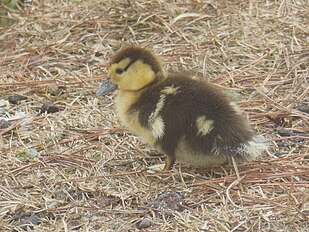


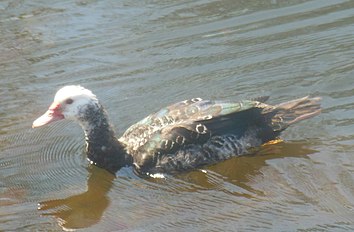


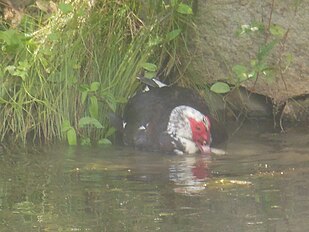

![Domestic ducklings after 25 days, left perhaps little distinction, the weight makes it clear that the male (1 and 2) are already heavier than the females (3 and 4).[37]](https://upload.wikimedia.org/wikipedia/commons/thumb/c/cd/Moscovy_ducklings_weight_after_25_days.jpg/890px-Moscovy_ducklings_weight_after_25_days.jpg)


